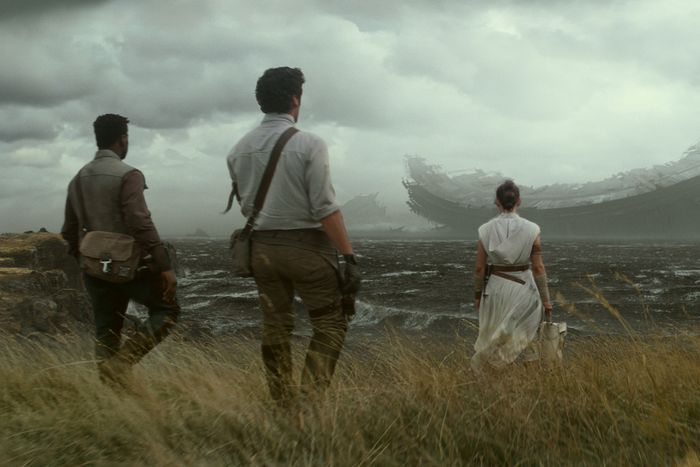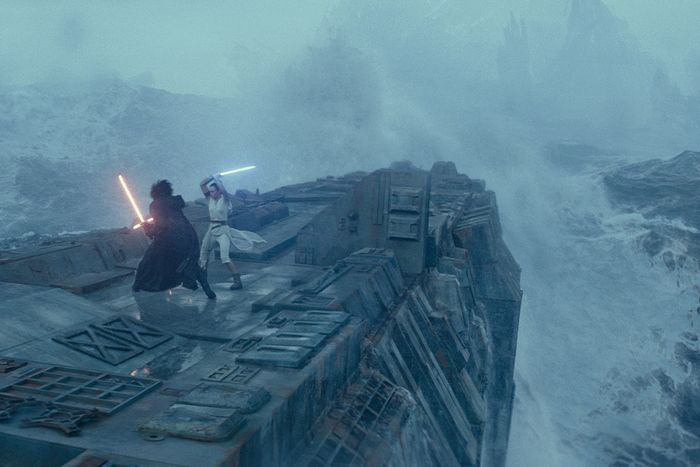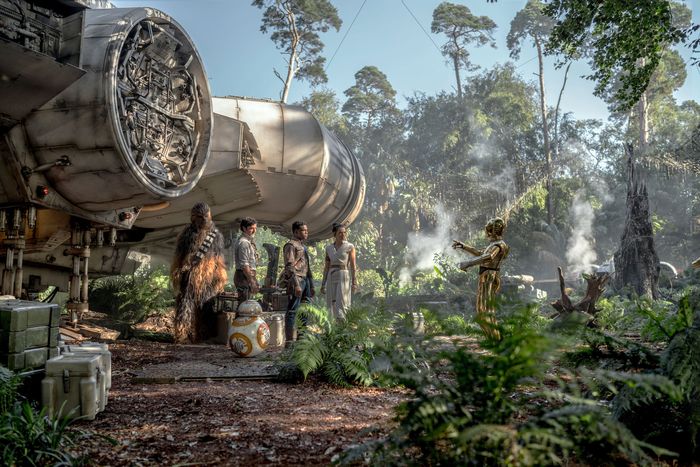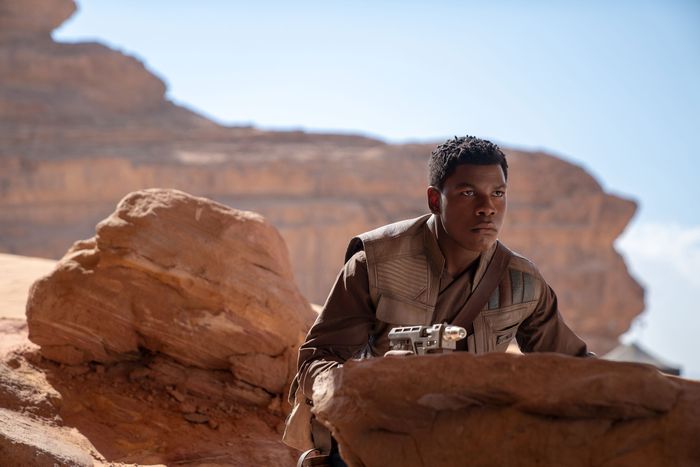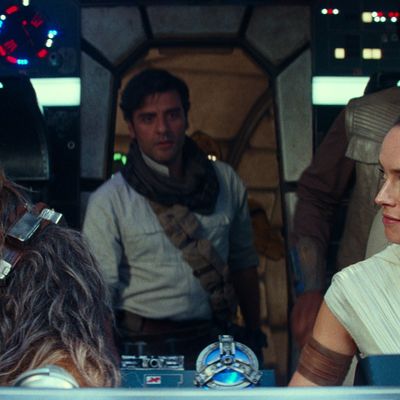
It turns out The Rise of Skywalker isn’t just a movie. It’s a greatest hits collection of all your favorite Star Wars *stuff*, packaged along with some truly hardcore deep cuts. In this way, Episode IX represents the totality of the franchise, critical warts and all. And if you think it felt overstuffed with obvious references — to Palpatine’s prequel days or a duel on the Death Star — there were just as many sly shoutouts to the Skywalker saga’s past. Here’s a guide to some of the subtler, deeper dives into the dark side, the light side, and everything in between.
Big spoilers ahead for The Rise of Skywalker.
A punctuation mark we don’t often see!
At the beginning of the film, the opening text crawl starts with the words “The dead speak!” An exclamation point has only appeared in one other opening text crawl: Episode III — Revenge of the Sith. “War!” it read. That film featured Palpatine teasing Anakin Skywalker with the possibility of immortality. Which leads us to …
Palpatine quotes himself from Revenge of the Sith.
When Kylo Ren discovers the Emperor on the planet of Exegol, the reborn Palpatine says, “The dark side of the Force is a pathway to many abilities some consider to be unnatural.” This is word-for-word what Palpatine said to Anakin Skywalker in Revenge of the Sith, when he’s dangling the promise of death-stopping powers. Funnily enough, both Ben Solo and Rey seem to have learned this power on their own?
The Emperor’s rebirth, cloning, his evil message, and the Sith Fleet, are all reminiscent of a 1991-1992 Star Wars comic-book series called Dark Empire.
The Emperor seems to have not only resurrected himself, but also to have cloned Supreme Leader Snoke (Andy Serkis), the primary villain from the previous two films. This is very much in line with an old-school Star Wars comic book called Dark Empire, in which the Emperor does the very same. In fact, in that same series, the Emperor sent out a threat to the entire galaxy, declaring his desire for revenge. Moreover, he was shown to have a fleet of “World Devastators” capable of ravaging entire planets. “Planet killers,” as Poe describes the cannons in The Rise of Skywalker, aren’t that far off from “world devastators.”
The Wayfinders look like “holocrons” from the Star Wars books, comics, and cartoons.
The tricky pyramid-shaped MacGuffins of the film look nearly identical to mystical devices called holocrons, which exist in the Star Wars Expanded Universe of the 1990s (and originate with Dark Horse Comics writer Tom Veitch). Sith holocrons also exist in more contemporary Star Wars canon. In the animated series Star Wars Rebels, Sith holocrons tempt the young Jedi Ezra Bridger.
Chewbacca cheating at holochess.
When Finn and Poe joke about Chewbacca perpetually winning at holochess (also called Dejarik), they casually mention that Chewie is about 250 years old. This is a mild retcon, because if you had the old storybooks from the ’80s (like the 1983 Return of the Jedi storybook, for example) you would have learned that Chewie was like 800 years old.
Of course, the joke about Chewie cheating at holochess is a nod to Chewie threatening R2-D2 during a game in the original Star Wars film. This movie seems to imply that Chewie doesn’t cheat at chess anymore, and is actually just good at chess now. Maybe R2-D2 taught him?
The “Forbidden” Sith language references a pivotal Star Wars Rebels episode.
And the Sith gets deeper! A major plot point of The Rise of Skywalker revolves around C-3P0 being unable to formally translate Sith writing owing to programming limitations. The obstacles recall a moment in the season-two finale of Star Wars Rebels, “Twilight of the Apprentice,” when Ahsoka Tano is required to translate ancient Sith writing, which she calls, “the Old Tongue.” We’ll hear more from Ahsoka later, quite literally.
Lando gets the most famous line in Star Wars (no, not that one).
Okay, so this may be obvious to some fans, but every Star Wars film contains the line, “I have a bad feeling about this.” But The Rise of Skywalker marks the first time Lando gets the line. Han Solo got the line in The Force Awakens, and in the previous film, BB-8, speaking in droid speak, got it.
Spice Running
Poe Dameron (Oscar Isaac) gets a backstory when we learn he used to run spice, which is basically the Star Wars version of a drug dealer. (There was even a joke about doing spice in The Mandalorian.) Han Solo was also an infamous smuggler of spice, which was prevalent on Kessel, the spot Lando and Han infiltrate in Solo: A Star Wars Story. Later in the timeline, C-3PO complains about maybe getting sent to the “spice mines of Kessel” in A New Hope.
Rey uses Baby Yoda’s best power to heal a sandworm.
If you watched the seventh episode of The Mandalorian right before The Rise of Skywalker, then you actually got a preview of Rey (and Ben Solo’s) newest power. When Rey heals a sandworm just by touching it, she’s proving she might be the greatest Jedi ever, but what about Baby Yoda, who technically demonstrated the power before her?
Moreover, taming a sandworm feels straight out of the classic Frank Herbert science fiction novel Dune, an influence on Star Wars.
Rey and Kylo Ren’s Force transfers were hinted at in The Last Jedi.
Thanks to their handy mind-link, Kylo Ren is able to reach across the space and snatch objects from Rey’s vicinity — from Vader’s mask to a necklace. While this power might seem unique to The Rise of Skywalker, it’s not. In The Last Jedi, Kylo Ren felt rain on his hands during a communication with Rey, who was on Luke Skywalker’s island, millions of light years away.
Rey quotes … Kylo Ren.
During a watery duel between Kylo Ren and Rey, she echoes words previously spoken by him in The Force Awakens. When Kylo Ren interrogated Rey in that film, and she told him she’d never help him, he said glibly, “We’ll see.” This time, Rey throws that back.
Leia and Luke’s flashback probably takes place in the Ewoks’ backyard.
As Luke narrates “the final night” of Leia’s training as a Jedi Knight, we are treated to 1983 versions of both Mark Hamill and Carrie Fisher, thanks to the magic of CGI. And, because they look about how they looked in Return of the Jedi, it’s possible this scene happened on the Forest moon of Endor, or, you know, the home of the Ewoks.
Why Leia didn’t become a Jedi.
Leia’s Force vision of the future echoes two other similar self-fulfilling prophecy paradoxes in other Star Wars movies. In Revenge of the Sith, Leia’s future-father, Anakin Skywalker, had a vision of his wife, Padmé, dying, which turned him into a busy body hellbent on attaining magic anti-death powers, which caused her to die anyway. Ditto Leia’s brother, Luke, who, in The Empire Strikes Back, had a vision that Han and Leia would get screwed over, tried to stop it, and then it happened anyway.
Leia’s clairvoyance is similar: Her vision tells her that becoming a Jedi would result in the return of the Sith. So, she quit being a Jedi, and in classic Star Wars fashion, the Sith came back anyway.
“Red 5” Luke’s X-Wing
After Rey intentionally crashes Kylo Ren’s TIE fighter on the planet Ahch-To, it’s not totally clear how she’ll get herself out of there once Luke talks her into getting back into the Jedi swing of things. Luckily, Luke sunk his X-Wing sometime after he became a hermit in The Last Jedi. In that previous film, Rey only saw Luke’s old ship for a minute, but here, we learn the old thing is up and running. When Luke levitates the ship out of the water, the scene mirrors the moment in The Empire Strikes Back, when Luke was unable to get his ship out of the swamp in Yoda’s presence. Appropriately, the music that plays as Luke glides the X-Wing to safety in The Rise of Skywalker is “Yoda’s Theme.”
And when the Resistance picks up Rey’s signal later, the ship is referred to as “Red 5.” This was Luke’s squadron number in the original Star Wars movie, when he blew up a the first Death Star. Interestingly, in Rogue One, which takes place just before A New Hope, we briefly saw another X-Wing designated “Red 5” get blown-up, thus leaving that number open for Luke to take. In most Expanded Universe canon, Luke Skywalker changes the name of “Red Squadron” to “Rogue Squadron” after they destroy the Death Star. This is why all the snow speeders call each other “Rogue 3” and “Rogue 2” in The Empire Strikes Back. In the classic N64 game, Rogue Squadron, Luke was “Rogue Leader,” and not “Red 5,” but hey, Red 5 sounds cooler.
Last fun fact about X-Wings: In the 1976 novelization of Star Wars (which actually came out before the movie), Luke’s X-Wing is “Blue 5,” because in early versions of the script, they were Blue Squadron, not Red.
The best Star Wars fighter pilot ever has a blink-and-you’ll-miss-it cameo.
It’s very easy to miss, but actor Denis Lawson is back as Wedge Antilles … for probably less than ten seconds. He’s the guy who says, “Nice flying, Lando,” while manning the laser turret in the Millennium Falcon. Wedge has the unique distinction of being one one of the few Star Wars pilots to have survived two Death Stars. He flew with Luke in A New Hope, was buzzing around with Rogue Squadron in those snow speeders in Empire Strikes Back, and in Return of the Jedi, Wedge and Lando are the two guys who destroy the second Death Star. In real life, Denis Lawson is Ewan McGregor’s uncle, and because McGregor has a voice cameo toward the end of the movie, this is the first Star Wars movie they’ve “appeared” in together.
Interestingly, though this is Denis Lawson’s fourth Star Wars movie, it’s only the third Star Wars movie to feature his own speaking voice. In A New Hope, Lawson’s voice was dubbed over by a voice actor named David Ankrum. (This is why Wedge bizarrely has an American accent in A New Hope.) Wedge is really popular among fans of the old books and comics, and even had his own series of books called X-Wing, which was all about Wedge running Rogue Squadron after Luke Skywalker went off to do more Jedi stuff.
Wedge also might have uttered the actual best line in all of Star Wars. In The Empire Strikes Back, after blowing up an Imperial Walker, he says, “Whoo-ha! That got em!”
Chewebacca’s medal was originally given to him by Carrie Fisher … in 1997.
In The Rise of Skywalker, Chewbacca finally gets what he was bizarrely denied in A New Hope, a medal for blowing up the Death Star! Because J.J. Abrams seemingly wanted to address every single loose end in Star Wars, he must have remembered that some people were upset about Chewie’s snubbing. This is a cute nod when you consider that Carrie Fisher herself actually did give Chewbacca his medal in 1997 at the MTV Movie Awards, when Chewie got the “Lifetime Achievement Award.”
Anakin and Obi-Wan lead the voices of Jedi past.
In what is undoubtedly everyone’s favorite scene in the movie, Rey calls upon the power of all the Jedi who have come before her, prompting a non-stop audio cameo party. If you stay and watch the credits, you’ll get a complete list of who was speaking to her, but crucially, we hear Ewan McGregor as Obi-Wan Kenobi say, “Rey, these are your final steps,” which echoes the Ewan McGregor voice cameo from The Force Awakens when he said, “Rey, these are your first steps.”
Joining Ewan are Liam Neeson as Qui-Gon Jinn, Samuel L. Jackson as Mace Windu, Frank Oz as Yoda, and … Star Wars drumroll please … Hayden Christensen as Anakin Skywalker.
Anakin’s encouragement is telling, urging her to “bring back the balance as I did.” This line is a pretty big deal if you care about the Star Wars prequels, because before the new movies, George Lucas liked telling everyone that Episodes I-VI were really the story of Anakin Skywalker restoring balance to the Force, even though he was Darth Vader like, more than half the time.
Wait, more Jedi voices … from the cartoons?
Actually, Anakin’s voice cameo wasn’t the biggest deal. Instead, the voices of Ashley Eckstein and Freddie Prinze Jr. are the voice cameos nobody saw coming. Along with three other voice actors from The Clone Wars cartoon — Luminara Undall (Olivia d’Abo), Aryla Secura (Jennifer Hale), and Adi Gallia (Angelique Perrin) — Eckstein stands out as the very recognizable voice of Jedi Ahsoka Tano, who, up until now, has only existed in the animated series The Clone Wars and Rebels. (The other three Jedi, listed above, all appeared in the prequel films, but never spoke, meaning their Clone Wars voice actors were needed for their film debut here.)
Prinze Jr., meanwhile, played the voice of surviving Jedi Kanan Jarrus in the series Rebels. Interestingly, though Kanan’s death was depicted onscreen in Rebels, Ahsoka was seemingly alive at the end of Rebels, which implies, sometime between the end of Return of the Jedi and The Rise of Skywalker, Ahsoka became one with the Force.
Of all the characters to include as Rey’s cheerleaders, Ahsoka is the possibly the coolest, because The Clone Wars established her as Anakin Skywalker’s apprentice — whom nobody talks about. Ahsoka is set to make her return to Star Wars in a new season of The Clone Wars on Disney+ in 2020. So, just like Baby Yoda was doing viral marketing for Force healing, Ahsoka is basically repping for herself.
The Emperor melting references Raiders of the Lost Ark.
Apparently, the end of the Skywalker saga is also the end of the Indiana Jones saga? When Rey finally defeats Palpatine, the gross old Sith gets his face melted off in a nearly identical sequence to the end of the first Indiana Jones movie, Raiders of the Lost Ark.
Luke and Leia’s theme music plays over most of the ending.
You could say that the ending montage of The Rise of Skywalker, complete with iconic locations (Cloud City) and beloved creatures (Ewoks), is cheesy as hell, and you would not be wrong. But there’s also a very real chance that you were crying throughout the whole thing. Abrams seems to be paying homage to George Lucas’s Special Edition ending of Return of the Jedi, showing the galaxy in full celebration now that the Emperor is really (really?) dead.
But, the thing that makes this scene work is the fact that one of John Williams’s lesser-known themes plays throughout. The theme is called “Luke and Leia,” and Williams wrote it for Return of the Jedi. The arrangement here is a little different than in 1983, but it’s the perfect piece for the ending of the saga. In The Last Jedi, we briefly heard the theme when Luke and Leia reunited on Crait, but this scene really gave this piece of music its moment in the sonic spotlight.
Rey’s lightsaber means she’s completed her Jedi training.
You might think that Rey igniting her nifty yellow-bladed lightsaber is just mindless fan service, but in terms of her journey, this moment makes clear that Rey has graduated to true Jedi status. Part of the deal of being a real Jedi is that you have to build your own lightsaber. To date, Rey has not done this; she’s gone three movies borrowing a lightsaber. But now, with her yellow-bladed saber, she’s done the thing. And as she looks out into those setting suns, it’s hard to believe that we won’t see Rey Skywalker in another brand new Star Wars movie someday.


